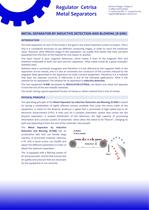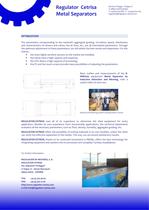 Website:
Regulator Cetrisa
Website:
Regulator Cetrisa
Catalog excerpts

METAL SEPARATOR BY INDUCTIVE DETECTION AND BLOWING (R-SIM) INTRODUCTION The total separation of 100% of the metals is the goal in any metal treatment system or project. This is why it is considered necessary to use different connecting stages, in order to reach the maximum value. However, after different stages in the separation, we usually find metals that have not been separated from the flow of the material for one reason or another. One basic reason is poor magnetic behaviour, which makes it inert to the magnetic flow and therefore inalterable in both iron and non-iron separation. What metal would be a good example?: Stainless steel. Stainless steel is extremely amagnetic and therefore it is not affected by the magnetic fields in the separation of iron metals, and it is also an extremely low conductor of the currents induced by the magnetic fields generated in the Separators by Eddy Currents equipment. Therefore, it is a material that does not separate correctly or effectively in any of the indicated applications. What is the solution for its separation? The solution for its separation is inductive detection. The new equipment R-SIM, developed by REGULATOR-CETRISA, can detect any metal and separate it from the rest of the non-metallic materials. The result: having a good separated fraction of metals or rather material that is free of metals. PHYSICAL PRINCIPLE The operating principle of the Metal Separator by Inductive Detection and Blowing (R-SIM) is based on having a combination of highly efficient sensors available that cover the entire width of the equipment. A metal on the detector produces a signal that is processed at high speed due to an electronic advancement (CPU). It then acts on a complex pneumatic system that carries out the physical separation. A studied distribution of the detectors, the high capacity of processing information and a precise system of pneumatic valves allow the metal to be “blown”, changing its path and separating it from the rest of the materials’ natural path. The Metal Separator by Inductive Detection and Blowing (R-SIM) has an acceleration belt that can handle large volumes of processed material. Likewise, a PC with a touch screen can modify and adjust the different parameters in order to obtain the optimum separation. The is equipped with a filtering system of air and pneumatic control that ensures the air quality and pressure that are necessary for the equipment to run correctly.
Open the catalog to page 1
OPTIMIZATION The parameters corresponding to the material's aggregate grading, circulation speed, distribution and characteristics of sensors and valves, the air flow, etc., are all interrelated parameters. Through the optimum adjustment of these parameters, we will obtain the best results and separation. For this reason, · the most highly sensitive sensors on the market are installed, · the valves have a high capacity and response, · the CPU allows a high capacity of processing, · the PC and the touch screen provide many possibilities of adjusting the parameters. Basic outline and...
Open the catalog to page 2All Regulator Cetrisa catalogs and technical brochures
-
Magnetic Drum Separator
2 Pages
-
MAGNETIC ROLLER (R-RM)
2 Pages








